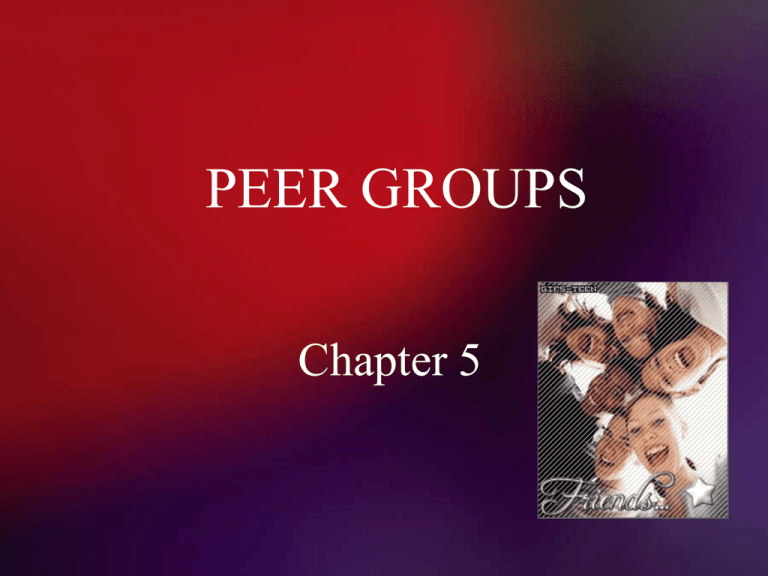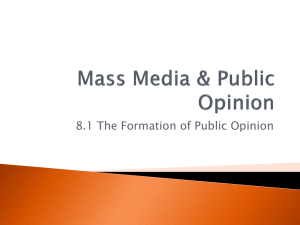
PEER GROUPS
Chapter 5
Think back…
…to your high school days…
What types of crowds did you see?
To which group did you belong?
The “nerds”? The “jocks”?
Peer Groups
• Groups of people who
are roughly the same age
• Modernization has led to
more age segregation
• U.S. high school seniors
< 15% of waking hours
spent with family
The Origins of Adolescent Peer Groups
in Contemporary Society
Educational Origins of Adolescent Peer
Groups
• Age grading in public schools
• Impact on social life has been staggering
• Organized activities outside of school
contribute to age segregation
The Adolescent Peer Culture:
A Problem or a Necessity
Is There a Separate Youth Culture?
• In most high schools, athletic and social
success are more reliable routes to
popularity than is academic success
• Argument: Rise in peer group power is
directly linked to rise in adolescent
problems
The Adolescent Peer Culture
• Margaret Mead: Socialization for Adulthood
– Postfigurative cultures: Culture change is slow
• What youth need to know comes through
contact with elders
– Cofigurative cultures: Culture changes
quickly
• Elders knowledge may be outdated
• socialization through contact with sameaged people
The Adolescent Peer Culture
Margaret Mead: Socialization for Adulthood
• Prefigurative cultures
– Culture change is very rapid
– Young people teach adults
– Example: Teaching parents how to burn
a CD
The Nature of Adolescent
Peer Groups
Changes in Peer Groups
during Adolescence
• There is a sharp increase
during adolescence in the
time spent with peers versus
adults
• Is there a boy/girl
difference? What does this
mean for boys? (see figure
p. 174)
The Nature of
Adolescent
Peer Groups:
How do they
spend their
time?
11
The Nature of Adolescent
Peer Groups
• Significant others
– Nearly half are the same age
as the teen
• Peer groups function much
more without adult supervision
• Increasingly more contact with
peers is with opposite-sex
friends
(what have we learned about
exposure to the opposite sex with
early maturing girls??)
Cliques and Crowds
• Cliques are small groups
defined by common
activities or simply by
friendship
• Crowds are larger, more
vaguely defined groups,
based on reputation
– Jocks, brains, nerds, druggies
Cliques and Crowds
Changes in Clique/Crowd Structure over
Time
• Over the course of adolescence, the
crowd structure changes
• allows adolescents more freedom to
change crowds, enhance status
Adolescents and their Crowds
• Crowds as Reference
Groups
– Crowds contribute to the
definition of norms and
standards for such things
as clothing, leisure, and
tastes in music
Adolescents and their Cliques: Similarity
among Clique Members
Adolescents’ cliques typically are
composed of people of the
• same age
• same race
• same socioeconomic background
• same sex - at least during early and
middle adolescence
Adolescents and their Cliques:
Common Interests among Friends
Three factors in determining
clique membership
• Orientation toward school
• Orientation toward the
teen culture
• Involvement in antisocial
activity
Adolescents and their Cliques:
Common Interests among Friends
• Deviant peer groups
– Aggressive adolescents gravitate toward
each other
– Gangs are deviant peer groups
• Process of antisocial peer group formation in
adolescence begins in the home during
childhood
– Parent-child relationships that are coercive
and hostile
Adolescents and their Cliques:
Common Interests among Friends
• Role of family in friendship choice
– Parents socialize certain traits
– Predispose teens toward certain crowds
– Crowds reward them for the traits that led
them there in the first place
– Traits are strengthened
• Antisocial peers reinforce antisocial traits
Popularity and Rejection in
Adolescent Peer Groups
• Chief determinant of popularity during
adolescence: Social skills
– Act appropriate in eyes of peers
– Meet needs of others
– Confident but not conceited
• Both boys and girls can be aggressive
and popular at the same time
• Aggression and poor emotion
regulation creates peer problems
Popularity and Rejection in
Adolescent Peer Groups
• Three types of unpopular
adolescents
– Aggressive
• fights with other students, bullies
others
– Withdrawn
• exceedingly shy, timid, and inhibited
• Victims of bullying
– AggressiveWithdrawn=combination
• Hostile, but nervous about initiating
friendships
Popularity and Rejection in
Adolescent Peer Groups
• Boys are more physically aggressive than
girls
• Girls also act aggressively toward peers,
but often engage in relational aggression
– Ruin a reputation
– Disrupt a friendship
The Peer Group
and Psychosocial Development
• Teens with poor peer relationships are
more likely to
– Be low achievers in school
– Drop out of high school
– Have a range of learning disabilities
– Show higher rates of delinquent behavior
– Suffer from emotional and mental health
problems as adults
The Peer Group
and Psychosocial Development
• In promoting normal development, peers
– Provide models and feedback in regard to
identity
– Influence self-image
– Assist the development of autonomy
– Provide a context for decision-making skills
– Interact in intimate and sexual relationships
– Influence one another regarding achievement




